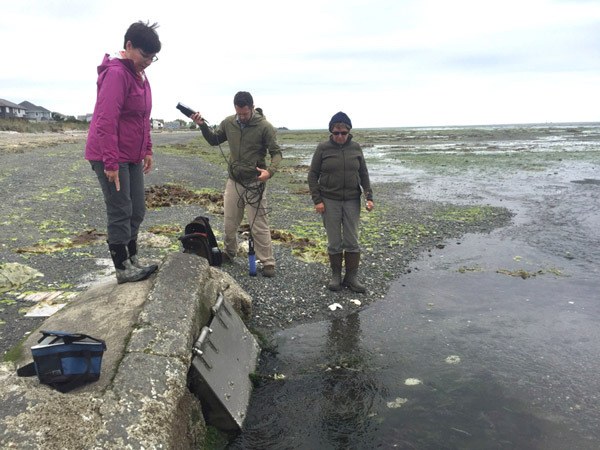by Grace Little
For the Sequim Gazette
For more than a year, Sarah Miller and the rest of her volunteer team have spent one to two days each month balancing on rocks and streambeds in every creek in the eastern part of Clallam County, from tiny creeks without names, to swampy wetlands, to the Dungeness River.
They gather data from the east county line to Bagley Creek for Streamkeepers of Clallam County, a citizen-based watershed monitoring program. These committed volunteers help to improve the health of Sequim’s watersheds by taking data connected with a multi-agency Pollution Identification and Collection project to identify and remediate pollution problems impacting shellfish in Dungeness and Sequim bays.
The PIC plan, devised in 2014 with the cooperation of Clallam County, the Clallam Conservation District, the Jamestown S’Klallam Tribe, and a host of other entities and individuals, takes a very practical approach to pollution cleanup: identify the watersheds contributing the most to pollution problems and then zero in on the pollution sources and clean them up.
It’s a model that has worked so successfully in other parts of the state that the Clallam County Health Department has received grant funding to implement it here. The Health Department turned to Streamkeepers to implement the monitoring component, given Streamkeepers’ long track record of successful, verifiable data collection and management, and its multifold leveraging of volunteer resources; volunteers prepare and calibrate the equipment, perform the monitoring, enter and check the data into the County Water Resources database, and analyze the data output for Quality Control requirements. Streamkeepers’ half-time coordinator Ed Chadd says that with a variety of projects that Streamkeepers volunteers conduct, “My job is to keep an eye on the three-ring circus, keep the guy-lines tight and negotiate the terms of our next show.” Volunteers do most of the rest.
Miller is the volunteer leader of this team, which deploys an electronic water-quality meter in the water at each site and then grabs and processes bacteria and nutrients samples to send to laboratories. Fecal coliform bacteria are the primary target of the sampling, because when their levels are too high in marine waters, they cause shellfish closures, thus harming the local economy and quality of life. These bacteria, which live in the guts of warm-blooded animals, enter the watersheds through multiple pathways, including failed septic systems, agricultural activities and pet waste.
Nutrient pollution (emanating from nitrogen and phosphorus compounds) causes problems such as harmful algae blooms in both fresh and marine water. Miller runs the nutrients samples through a filter in the trunk of her car, which functions as a sort of traveling lab for the day, full of neatly ordered, ice pack-laden coolers for keeping samples at a low temperature, paper towels and gloves ready in their dispensers and sampling bottles labeled with site names.
Miller takes the fecal samples to be analyzed at the County Environmental Health lab and ships the nutrients samples to the University of Washington. The conclusions from the data analysis inform the priorities for cleanup efforts.
Most of Miller’s team aren’t originally from Clallam County. They describe Streamkeepers as a “great introduction to the Olympic Peninsula,” a way to see the landscape close-up and understand the ecosystem more deeply.
At the stream, the volunteers also test for a variety of other parameters to accompany this data. They measure flow, water temperature, turbidity, dissolved oxygen content and more. With the recent purchase of a state-of-the-art water quality meter, this testing is much easier than in times past and all the data can be gathered in a few minutes. The volunteers are thrilled about this because it’s not so much fun standing in a creek in the rain in December waiting for a meter to stabilize!
“It’s great to be making a difference,” Miller concludes, looking out at Dungeness Bay. “The water quality in the bay is improving and we’re a piece of that puzzle.”
If you’d like to volunteer for Streamkeepers, email Streamkeepers@co.clallam.wa.us, call 417-2281 or visit our website at www.clallam.net/SK for more information.
Streamkeepers seeks volunteers
Streamkeepers, Clallam County’s volunteer stream monitoring program, seeks new volunteers to help collect stream health data, perform data entry and analysis, and conduct education and outreach.
As the program continues to expand, there is a continuing need for volunteers. New volunteers join existing stream teams and perform quarterly stream monitoring and other stewardship activities, on streams throughout the county or may volunteer to provide other kinds of program support, both outdoors and indoors. Most recently, Streamkeepers volunteers submitted over 20,000 data records to the Washington State Department of Ecology to restore Clallam County’s streams.
Streamkeepers’ annual training begins on July 25 and consists of two introductory evening sessions and a full-day class including both indoor and outdoor instruction. Trainees will learn how watersheds provide services to fish, wildlife and people; what threatens local watersheds; and why and how Streamkeepers monitors them. No previous experience or special equipment is required. Training is scheduled around the availability of the trainees, so if you’d like to participate, contact Streamkeepers at 417-2281 or streamkeepers@co.clallam.wa.us. Streamkeepers’ website is at www.clallam.net/SK/.
Grace Little is an advancing senior at Whitman College in Walla Walla, majoring in communications. Since her youth, she’s spent her summers at a cabin her grandfather built in Sequim.



